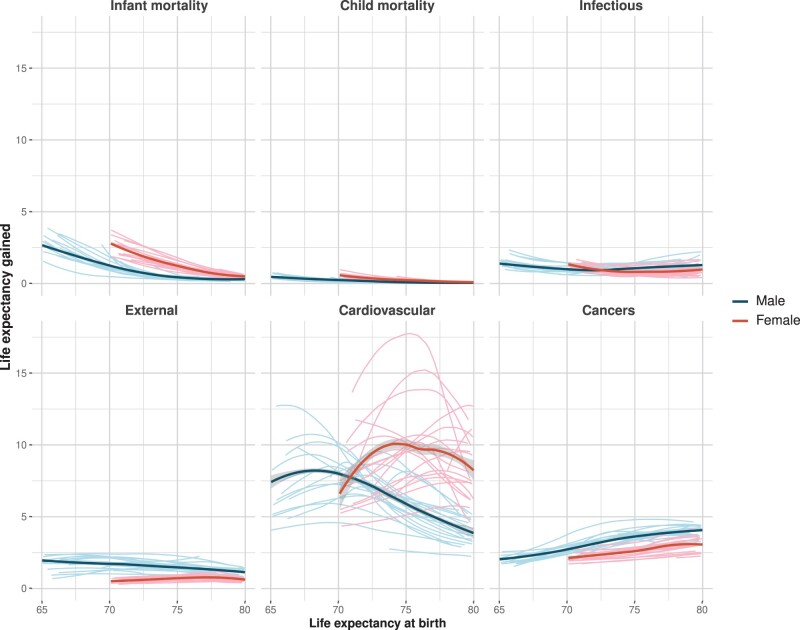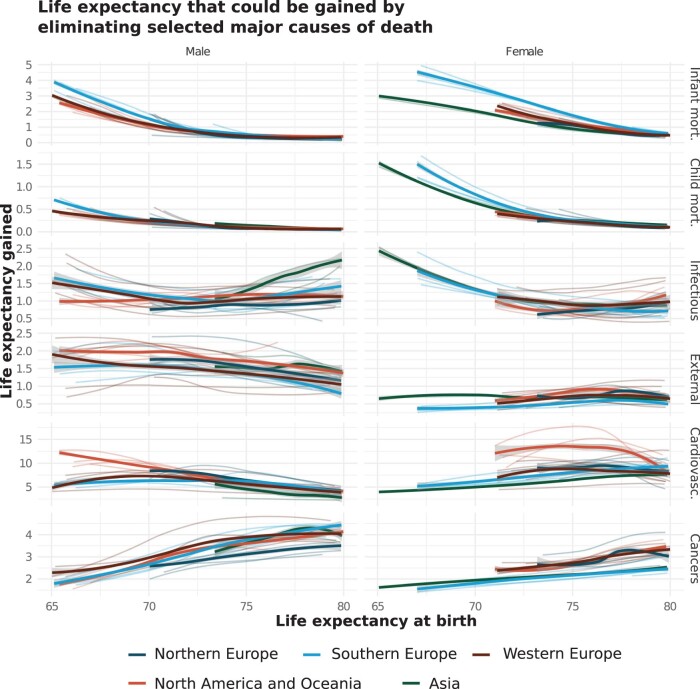Omran’s epidemiological transition is one of the main theories of global mortality change. In his initial paper, Omran1 outlined a broad model that sought to link epidemiological and social factors with the demographic transition theory—the major population theory which described population growth as arising from the lag between declines in death and birth rates, while population age structures transitioned from young to older.2,3 Omran sought to draw a deeper focus on the mortality determinants of demographic transition, which had received comparably less attention than the determinants of fertility decline.4
In this way, Omran classified human populations into distinct stages, each characterized demographically (levels and volatility of death rates, fertility rates, and population growth rates) and epidemiologically (cause-of-death contributions). His initial paper had three ‘Ages’ (the age of pestilence and famine, the age of receding pandemics and the age of degenerative and man-made diseases), and Omran himself later expanded this to include the age of declining cardiovascular mortality, ageing, lifestyles modification and emerging and resurgent diseases, and a fifth yet-unrealized age of aspired quality of life.5 The core theoretical value of the epidemiological transition is that, given some information on the level of mortality in a population (such as life expectancy at birth), we should be able to meaningfully infer a host of current and future population characteristics including growth and fertility rates and cause-of-death profiles.
But does the theory really provide accurate inferences? If we focus just on the relationship between level of life expectancy and cause-of-death profiles, an immediate challenge is that the theory is presented deterministically across the four stages: between Stages 1 and 3, populations transition from low life expectancy and mortality regimes dominated by infectious mortality primarily among children, to regimes dominated by cardiovascular diseases. Between Stages 3 and 4, life expectancy continues to increase to levels above 75 years, with cardiovascular mortality leveling off and starting to decline. Whereas Omran’s initial model distinguished between different variants of the epidemiological transition, these variants differed primarily on the pace and social-technological mechanisms driving transitions between the different stages, not on the variations of the stages themselves.
What has remained elusive, is whether there is high within-stage variation in the evolution of causes of death among different populations and across sexes, which might undermine the predictive power of the theory. For the theory to be useful, it should be able to guide predictions that inform health priorities. For example, it should predict cause-of-death profiles in countries with incomplete cause-of-death statistics, or guide predictions of how causes of death will evolve in the future. Otherwise, the epidemiological transition theory should be relegated to a stylized description of a transition that took place in a handful of early-industrializing countries.
Whereas few countries have accurate cause-of-death data at low life expectancies, we can reliably observe the epidemiological transition between the ages of ‘degenerative and man-made diseases’ and ‘declining cardiovascular mortality, aging and emerging and resurgent diseases’ in several world regions (see Supplementary Appendix for data and methods, available as Supplementary data at IJE online). This can tell us if there is actually a universal path to low mortality.
Relationship between life expectancy at birth and the burden of each cause group by sex
In Figure 1 we graph, at each life expectancy level, the mortality burden by broad cause-of-death groupings. We operationalize ‘burden’ as the potential years of life expectancy gained by total elimination of a group of causes, estimated using cause-deleted life table methodology. This measure has the advantages of more strongly weighting causes of death at ages with more remaining life-years and of providing comparable burden estimates across regions and over time.6
Figure 1.
Relationship between life expectancy at birth and the mortality burden of each cause of death. aWe estimated life expectancy gained as the change in life expectancy at birth between the observed and cause-deleted life table for each cause separately. bThe individual lines are the country-specific series; the bold lines are the loess smoothing lines. cInfant mortality is deaths from all causes between ages 0–1; child mortality is deaths from all causes between ages 1–5, and infectious disease mortality here is only among those aged 5+
We observe broad trends consistent with the epidemiological transition theory: for both sexes and every country, cardiovascular diseases carried the largest mortality burden for the majority of the transition between a life expectancy of 65 and 80, with a declining role for infant and child mortality. However, the magnitude of cause burdens when countries were at similar historical levels of life expectancy was not universal—especially for cardiovascular disease mortality. For example, at a life expectancy of 75, cardiovascular diseases carried a burden of 16 potential years of life expectancy among Australian women compared with just 2.5 years among South Korean men. We also observe a substantial, and sometimes even increasing, burden of infectious disease mortality in some countries that were already in advanced stages of the transition when life expectancy is high. This finding conflicts with the epidemiological transition, which postulates that the impact of infant and infectious disease mortality should be negligible at these levels of life expectancy.
Beyond this individual country variation, there was also important variation by sex. Compared with men, women had a consistently higher burden of infant mortality at all life expectancy levels, a higher and later peak in the burden of cardiovascular disease mortality and a lower burden of external and cancer mortality.
Regional differences in the relationship between life expectancy at birth and the burden of each cause group
A large part of the across-country variation we observed in Figure 1 is largely structured by geographical regions—especially for women (Figure 2). We observed substantially higher burdens of cardiovascular disease mortality in North America and Oceania and a conversely low burden in Southern Europe and Asia. Similarly, we observe substantially lower burdens of cancer mortality in both Southern Europe and Asia relative to the other three regions. There is also important variation in infant and infectious disease mortality. Southern Europe had the highest burden of infant mortality across every level of life expectancy whereas Asia held the highest burden of infectious mortality at most life expectancies.
Figure 2.
Relationship between life expectancy at birth and the burden of each cause, separately by region. aWe estimated life expectancy gained as the change in life expectancy at birth between the observed and cause-deleted life table for each cause separately. bThe individual lines are the country-specific series; the bold lines are the loess smoothing lines. cWe only show smoothed trends for life expectancy levels where there are data for at least three countries within the region, with the exception of the Asian region which just has Japan and South Korea dWe show each cause with a different y-axis to ensure that the variation is visible. As such, these graphs are not meant for a comparison of the contributions across causes but rather within causes
What does the epidemiological transition mean for low- and middle-income countries?
Without high-quality data from a broad set of countries, it is challenging to assess the accuracy of Omran’s depiction of high-mortality populations in either the past or the present. But it is reasonable to assume that some combination of infectious disease, famines and war kept death rates high, and that countries transitioning to a low-mortality profile would do so with a substantial transformation in the age and cause-of-death distribution; but as countries enter advanced stages of the transition, as shown here, it becomes more difficult to accurately characterize mortality profiles.
This is important because it defies the value of the epidemiological transition to estimate and predict cause-of-death mortality levels in contexts where this information is needed now for policy, such as in low- and middle-income countries (LMICs). Moreover the increased global heterogeneity in mortality profiles, combined with emerging infectious diseases in many LMICs, suggest that the epidemiological transition will fail to appropriately characterize cause-of-death mortality in these countries, casting further doubt on its value in LMICs. Omran’s own interpretation of transition in LMICs is problematic and embodies offensive tropes, particularly in his 1998 publication, including for example that ‘internationally sponsored’ medical efforts were the source of mortality decline in these countries and that high fertility ‘was considered the proof of a woman’s fecundity and a man’s virility’.5
We find that the later phases of the epidemiologial transition are far from universal, even among a relatively small set of now high-income countries. Whereas the broad stylized facts of the relationship between life expectancy and causes of death are consistent across countries—a high burden of cardiovascular mortality starting as low as a life expectancy of 65, a declining burden of infant and child mortality and a steadily increasing burden of cancers—we observe a tremendous amount of variation beyond these stylized facts, structured strongly by sex and geographical region. Importantly, our results only apply to the later stages of the epidemiological transition and do not directly contradict or invalidate the earlier, more classical, stages of the epidemiologic transition. However in prior work, Preston and Nelson (1974) take a similar approach to ours, using data from 1861 to 1964—when many countries were still in the classical stages of the epidemiological transition—and similarly find evidence of large variation in the burden of different causes of death across countries at similar levels of all-cause mortality.7
There are multiple epidemiological paths to low mortality, and the cause-of-death compositions of these transitions are too variable at higher life expectancies to be summarized in deterministic stages.
Ethics approval
This study was exempt from ethical approval since it uses aggregated, publicly available mortality data.
Supplementary Material
Contributor Information
Nikkil Sudharsanan, Professorship of Behavioral Science for Disease Prevention and Health Care and Institute for Advanced Study, Technical University of Munich, Munich, Germany; Heidelberg Institute of Global Health, Heidelberg University, Heidelberg, Germany.
José Manuel Aburto, Leverhulme Centre for Demographic Science, Department of Sociology and Nuffield College, University of Oxford, Oxford, UK; Interdisciplinary Centre on Population Dynamics, University of Southern Denmark, Odense, Denmark.
Tim Riffe, OPIK, Departamento de sociologia y Trabajo Social, Universidad del País Vasco (UPV/EHU), Leioa, Spain; Ikerbasque, Basque Foundation for Science, Bilbao, Spain; Max Planck Institute for Demographic Research, Rostock, Germany.
Alyson van Raalte, Max Planck Institute for Demographic Research, Rostock, Germany.
Data Availability
All data are freely available and automatically downloaded using the code deposited in an Open Science Framework (OSF) reproducibility repository [https://osf.io/vwd37/?view_only=8e1a9f4ab1f642a7a811b199ab0e27b5].
Supplementary data
Supplementary data are available at IJE online.
Author contributions
Data analysis and visualization: N.S. and T.R.
Writing and reviewing the manuscript: N.S., A.vR., T.R., J.M.
Funding
N.S. received funding from the Alexander von Humboldt Foundation. J.M. received funding from the British Academy’s Newton International Fellowship (NIFBA19/190679). A.vR. received funding from European Research Council (716323).
Conflict of interest
None declared.
References
- 1. Omran AR. The epidemiologic transition: a theory of the epidemiology of population change. Milbank Mem Fund Q 1971;49:509–38. [PubMed] [Google Scholar]
- 2. Davis K. The world demographic transition. Ann Am Acad Pol Soc Sci 1945;237:1–11. [Google Scholar]
- 3. Kirk D. Demographic transition theory. Popul Stud (Camb) 1996;50:361–87. [DOI] [PubMed] [Google Scholar]
- 4. Caldwell JC. Population health in transition. Bull World Health Organ 2001;79:159–60. [PMC free article] [PubMed] [Google Scholar]
- 5. Omran AR. The epidemiologic transition theory revisited thirty years later. World Health Stat Q 1998;53:99–119. [Google Scholar]
- 6. Beltrán-Sánchez H, Preston SH, Canudas-Romo V.. An integrated approach to cause-of-death analysis: cause-deleted life tables and decompositions of life expectancy. Demogr Res 2008;19:1323. [DOI] [PMC free article] [PubMed] [Google Scholar]
- 7. Preston SH, Nelson VE.. Structure and change in causes of death: an international summary. Popul Stud (Camb) 1974;28:19–51. [DOI] [PubMed] [Google Scholar]
Associated Data
This section collects any data citations, data availability statements, or supplementary materials included in this article.
Supplementary Materials
Data Availability Statement
All data are freely available and automatically downloaded using the code deposited in an Open Science Framework (OSF) reproducibility repository [https://osf.io/vwd37/?view_only=8e1a9f4ab1f642a7a811b199ab0e27b5].




